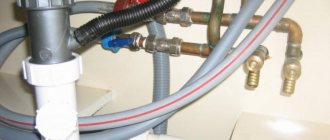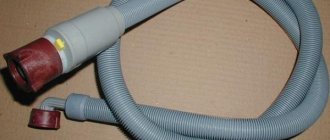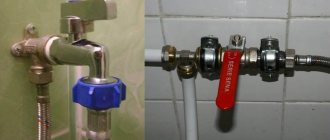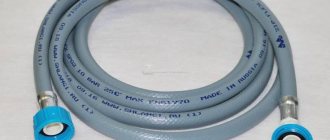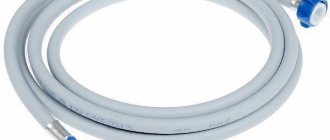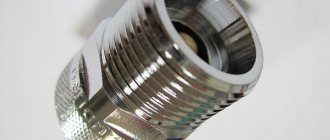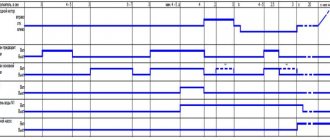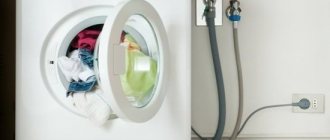The last stage of connecting to the water supply is installing the washing machine inlet hose
Today we have to figure out how to connect a washing machine to the water supply. We will get acquainted with several solutions of varying complexity, differing in the ease of operation of the automatic machine and the fittings involved. In addition to water supply, methods of draining water from draining the machine into the sewer will be discussed. Let's get started!
Purpose of the inlet hose
The inlet hose is a device for connecting the washing machine to the water supply system. Through it, water is supplied to the internal elements of the washing machine. Due to work under pressure, cast products are manufactured using a special technology using reinforcement. The usual material for the manufacture of such an element is polyvinyl chloride with a nylon lining. The connecting parts can be made of plastic, aluminum or steel. If the fittings are plastic, you need to tighten and unscrew them by hand, without using wrenches.
How to install aquastop yourself
If you purchased a washing machine without an aquastop, then you have the opportunity to install this system yourself. We will tell you how to do this point by point:
- First, you need to disconnect the washing machine from the electricity and water supply;
- Next, you need to disconnect the hose that supplies water to the structure (At the same time, you can check it and, if necessary, replace the rubber seals (shown as rings) and also clean and rinse the coarse filters);
- The sensor itself must be installed on the water supply tap, and must be turned clockwise, which is important;
- Then we connect the inlet hose to the aquastop system;
- Before completing installation work, you should make sure that everything is in good working order and reliable. This can be done by slowly letting water into the inlet hose, so you can find any problems and fix them.
Technical features
Before extending the hose, you must understand its parameters. Remember: in no case should you raise it higher than 1 meter so that the drainage pump can normally pump waste water out of the tank. If you neglect this recommendation, the low power of the pump will not be enough to drain, and water will linger in the tank.
During connection, you must take care to keep the tube tension free, especially paying attention to the top point. It should be 60 cm higher than the lowest point. This is typical for all machines, regardless of brand and model. But still, if you have everything calculated down to the centimeter, you need additional information. To find out the exact value, look at the user manual - everything is spelled out there. If nothing is indicated in the manual, look for other technical documentation for the SM.
Connecting the water supply hose
Usually, when installing a water supply system, during the renovation of an apartment or house, installation locations for household units whose operation is related to the use of water are provided in advance. These are primarily washing machines and dishwashers. In these places, an experienced installer must install special connection taps. Special hoses for supplying water are subsequently connected to them.
The usual sizes of taps are ½ and ¾ with external thread. Hose nuts also have this dimension. The connection is made with the tap closed.
Before screwing the tube, you need to make sure that there are sealing gaskets. It happens that they come included and require installation. In some cases, they are simply lost during transportation. After making sure that the gaskets are present, you can connect the water hose.
Table of the main causes of inlet hose leaks
Causes of malfunction Elimination
| The connection between the hose nut and the unit fitting has become loose and the rubber gasket has worn out. | It is necessary to tighten the nut or replace the gasket with a new one. |
| Damaged water supply hose, external mechanical impact or long service life of the product. | The location of a water leak can be anywhere in the product; most often these are micro cracks that are difficult to immediately detect. It is necessary to remove the product and carefully check it in good lighting. If a leak is detected, do not repair (glue). The best solution is to replace it with a new one. |
Types of aquastop
The following varieties exist:
- Aquastop UDI. It is a system for instantly stopping the water of a washing machine. It fires within 1 second. Externally, this part looks like a threaded pipe that can be connected separately to the machine. This part only works when there is a sharp drop in pressure. In other words, it will not fix small leaks right away.
- Built-in aquastops. Washing machines with this system are more expensive. There are two types of such aquastops: simple and with a valve that operates automatically. Simple ones are located at the bottom and turn off the moment the water leaves the tank body of the machine.
- Powder hitchhiking. It includes a hose for connection. One end is connected to the water supply, and the other to the washing machine. It should be noted that such a hitchhiker is disposable, since the water in it is absorbed using an absorbent. When water leaks in a double hose with empty walls, a very violent reaction begins. The valve will shut off the water supply to the washing machine and the problem will be eliminated. Such an aquastop system can protect against a couple of holes and can hardly be considered reliable protection for a machine.
Master services
If you have doubts about the correct connection of the machine, it is better to seek help from a specialist. This can be either a private master or an employee of a company service center.
The main thing is that he does not require prepayment , and the fact of connecting the device can be documented by providing the corresponding receipts.
The average cost of work is 1200 rubles. Depending on the region and company, the price may vary up or down.
Inlet hose with aquastop
Many manufacturers have turned even such a simple device as a water connection hose into a leak protection system. Devices with aquastop almost completely eliminate leaks as a result of damage to the internal hose.
The design of such elements consists of two shells located one inside the other. When the inner tube breaks, the outer shell retains water. In the part of the hose connected to the tap there is a mechanical valve that shuts off the water. It is powered by a special composition that expands when wet. Most models of products with hitchhiking have devices that signal when the valve is activated. A serious disadvantage of such equipment is the need for replacement after the valve in the protective block is activated. The outer wall is made quite strong and can withstand pressure up to 70 Bar (in a conventional pipeline this value does not exceed 10 Bar).
Additional measures
It should be noted that in addition to installing an aquastop in the machine, there are other ways to prevent leaks.
- The water pipes leading to the washing machine must be made of durable material. As a rule, pipes made of polypropylene or metal-plastic are used. Copper and galvanized steel pipes are also used. It should be noted that galvanized steel pipes have the shortest service life among all the above options (up to thirty years). Polypropylene pipes have proven themselves well. However, they can be damaged under strong mechanical stress. Craftsmen do not recommend installing fitting systems and taps made of aluminum. Such a part can burst under high pressure.
- Make a bathroom floor from waterproofing material. This will prevent flooding of the neighbors below. If such a floor is laid correctly, the water will go down the drain on its own.
- Turn off riser valves when you are not at home. This action must be performed primarily in cases where the drain hose of the machine is damaged. This recommendation is contained in almost any washing machine manual, but most people do not follow this advice.
Leak-proof hose
Aquastop UDI is a protection system designed specifically to shut off the water supply in the event of water leaks associated with damage to the inlet hose of the washing machine. This type of protection cannot one hundred percent guarantee that water will stop in the event of a leak; be careful.
A modified version is a hose, the valve of the protective block of which is actuated by permanent magnets facing each other with like poles. When water gets in, the magnets rotate and activate a mechanism that shuts off the water. Unfortunately, this device can only be used once.
The third type of flooded products with leakage protection has a protective device with a solenoid valve. If the machine is turned off, the valve (plunger) is closed. When the unit is turned on, voltage is applied to the electrical winding and the valve opens, providing water supply. The electrical control wires in such devices are reliably protected by a waterproof sheath.
Life time
Filling hoses from well-known manufacturers can serve properly for 5 years or more. During operation, it is necessary to ensure that there is no risk of mechanical damage and contact with aggressive acid- and alkali-containing substances on the surface. In addition, you should not save on the connection tap. The best option is to turn off the tap after using the washing machine until the next wash. This will relieve internal pressure and extend the life of not only the filling product, but also the solenoid valve responsible for shutting off the water.
If the water supply system does not have a connection tap installed, it can be integrated into the system using tees and adapters. If installing plumbing is not your thing, it is better to entrust such work to the experts. An experienced plumber will not only install the faucet, but will also be able to correctly connect both simple hoses and those equipped with leakage protection. The latter option is preferable, especially for residents of the upper floors of multi-story buildings.
Rate this article
( 10 ratings, average 4.3 out of 5 )
Do-it-yourself installation of aquastop
You can install it yourself. To do this you need to do the following:
- Disconnect the washing machine from the power supply and water supply.
- Disconnect the hose required for water supply from the washing machine. At this stage, it may be necessary to replace the o-rings, as well as wash the coarse filters.
- Install the sensor on the water supply tap. In this case, the device must be turned clockwise.
- Connect the inlet hose to the aquastop.
- Check the quality of the system installation. To do this, you need to carefully release water into the hose. If any malfunctions are found, correct them immediately.
Partial protection against leaks
To protect against leaks, a special tray with a built-in float can also be used. When water enters the pan located under the washing unit, the float rises and closes the switch contacts. A signal is sent to the control unit, the washing process is interrupted, and the pump begins to pump out water.
Replacing the inlet hose
If the water supply hose has visible damage and is leaking water, there is no need to repair it. These attempts will lead to nothing. You need to buy a new one and replace it. Before purchasing, be sure to check the length of the filler tube and the dimensions of the connection elements. It’s even better to take the old hose with you and the sales consultant will select an analogue. Before replacing, it is necessary to turn off the connection valve to reduce the pressure in the hose. To do this you need to wait for a few minutes. If this is not done, the forces applied to unscrewing can lead to damage to both the tap and the fitting. After dismantling the damaged element, a new one should be installed as described above.
Preparing for work
Select a hose according to the required characteristics:
- The working pressure of the liquid that the product can withstand . High-rise buildings require products designed for a pressure of 20 bar. In private buildings, this parameter corresponds to a pressure of 10% more.
- Maximum permissible temperature. Usually for the machine they take sleeves that do not deform at +90°C and above. The operating parameter of the sleeve sold together with the washing machine is at +100°C.
Tool for work:
- screwdriver for disassembling part of the housing;
- pliers for disconnecting the hose from the pump;
- a set of wrenches for unscrewing nuts.
A ¾-inch brass nipple and special connectors are purchased for the tube. You will need FUM tape to seal the joints.
The required extension length is also taken into account. The hose should not be stretched; sagging and loops are not allowed.
